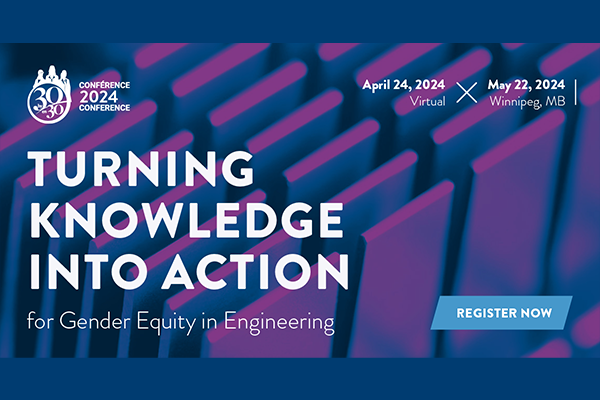

March 8 is International Women’s Day, a global day of unity, celebration, reflection, advocacy, and action. It is an occasion to recognize and celebrate women’s and girls’ social, economic, cultural, and political achievements, and to raise awareness of the progress made towards achieving gender equality—and the work remaining to be done.
The Government of Canada’s theme for International Women’s Day (IWD) 2024 is Invest in women: Accelerate progress. A call to action and a reminder that gender equality is one of the most effective ways to build healthier, more prosperous, and more inclusive communities, this theme resonates deeply with the engineering community.
For over three decades, Engineers Canada has been at the forefront of efforts to increase women’s representation in engineering. In 2014, Engineers Canada launched the national 30 by 30 goal: to see 30 per cent of newly licensed engineers be women by 2030. Ten years on from the launch of that national goal, and six years before 2030, we are reflecting on the work that has been done and the progress achieved, and the lessons learned that will guide us in the work that still remains to achieve greater equity, diversity, and inclusion in engineering.
“As we mark International Women’s Day, we are more determined than ever to action the lessons we’ve learned,” says Gerard McDonald, CEO of Engineers Canada. “With our upcoming 30 by 30 Conference, we are uniting the engineering community to refocus our efforts and create meaningful change to advance gender equity in engineering.”
Looking back on the first decade of 30 by 30
Over the past five years, we’ve seen some positive indicators in the representation of women in engineering. The number of women enrolled in and graduating from post-secondary engineering programs continues to grow. The number of newly licensed engineers who are women has also grown over the last five years, as has the number of women in the engineering profession. Women comprise 15 per cent of the engineering profession, compared to 13.5 per cent five years ago.
“However, a gender gap still clearly exists at all points of the engineering spectrum: from fewer girls than boys taking pre-requisite physics classes in high school, to an enrollment gap in post-secondary engineering programs, to underrepresentation in the engineering profession. Despite incremental progress, we must do better to achieve greater gender equity in engineering,” says Kim Bouffard, Engineers Canada’s Manager, Belonging and Engagement.
While engineering faces unique challenges in increasing women’s participation, it is also reflective of problems that are systemic across other industries in Canada, and around the world. For example, since 2020, we have seen Canada slip from 19th to 30th on the World Economic Forum gender gap index. We also see persistent gender gaps in engineering occupations in other countries. We have experienced a pandemic that studies have shown exacerbated some of the already existing gender disparities.
As we reflect back on the last 10 years of 30 by 30, Engineers Canada recently engaged Prairie Research Associates to conduct a review of 30 by 30 thus far. They’ve compiled an environmental scan of many of these topics: the wide range of interest holders in the engineering ecosystem who impact on women’s participation in engineering; statistics on women’s participation in engineering from youth STEM activities to post-secondary engineering education, to the profession itself; a review of the existing research into barriers to women in engineering; an overview of external trends including the COVID-19 pandemic and labour market trends; and a scan of similar initiatives and what takeaways they can offer 30 by 30. They’ve also prepared a formative evaluation of 30 by 30, including focus groups with interest holders to get their feedback on 30 by 30—its relevance, impact, and areas for improvement. This work will serve as our foundation as we regroup and refocus our gender equity work moving forward to 2030.
Accelerating progress: Turning knowledge into action

It is with this in mind that Engineers Canada designed this year’s 30 by 30 Conference with its theme of Turning Knowledge into Action for Gender Equity in Engineering. We will take the research and lessons learned over the past ten years of 30 by 30, and turn them into action to accelerate progress towards our goals.
Prairie Research Associates will present a keynote presentation on what they uncovered during their recent environmental scan and evaluation of the 30 by 30 initiative. This keynote will set the stage for deeper discussions throughout the day, including during breakout sessions for engineering employers, higher education institutions, and regulators, and during the closing session entitled, Beyond 30 by 30: Lessons learned, when panellists will discuss what the next six years of 30 by 30 will bring.
“It is clear that everyone in the engineering ecosystem can and must contribute to the ultimate goal of gender equity in engineering,” says Jeanette Southwood, Vice President, Corporate Affairs and Strategic Partnerships at Engineers Canada. “From regulators to higher education institutions, to elementary and secondary schools, to employers, all have a role to play in building a future where everyone can reach their full potential.
So join us in Winnipeg on May 22 as we mobilize around solutions to achieve greater gender equity in engineering.


